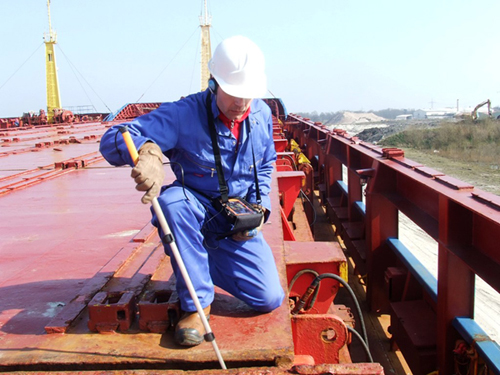Testing The Water Tightness Of Your Hatches
Poor maintenance of hatch-covers, seals and coamings, resulting in water entering a ship’s hold can lead to devastating consequences

Testing that hatch covers are weather-tight is a fundamental requirement for preventing damage to cargo and ensuring the safety of a vessel and its crew. Ultrasonic testing is the preferred method of inspection by P&I Clubs but there are others in use.
Light Testing
Hatches are fully battened down and a Surveyor will view the underside of the covers to see if any visible daylight is shining through gaps. If the sunlight level is insufficient a strong torchlight will be shone directly from above instead. This is the simplest method for identifying defects and their location but it may not be so easy to identify very small gaps.
Chalk Testing
Chalk powder is applied to the coaming compression bars and panel cross seams, the hatches are then closed and re-opened. The rubber joints are carefully examined. If there are irregularities in the chalk markings then it is assumed that these areas are not weather-tight. This method was the traditional way for testing hold cover compression but does not test the watertight integrity of the hold. IACS states that this test should be followed by a hose test.
Hose Testing
The hatches are secured, with one surveyor in the hold. On deck a constant jet of pressurised water is then directed at the hatch-cover seams and joints. Any water leaking into the hold should then be seen by the Surveyor inside, indicating a defect in the seams or joints. Although the most common method of testing hatch-covers, this method does have a number of disadvantages:
• The hold must be empty
• A minimum of two surveyors required
• It cannot be performed in sub-zero temperatures
• Run-off from the deck which can lead to pollution - some port authorities will not permit this
• It cannot accurately pinpoint leakages as water might travel along drainage channels and enter the hold at a different point or travel through the drain valves and back onto deck
• Variance in water pressure and distance of the jet can affect results
• Time consuming.
Ultrasonic Testing
This is an accurate, repeatable and convenient method of testing hatch-covers, doors, ventilators, access hatches, etc.
A transmitter emitting ultrasound is placed in the hold and the hatches are then fully closed. On deck the surveyor wearing headphones will walk around the periphery of the covers using a hand-held receiver or detector and will be able to hear ultrasound leaking through any defective seams or joints - even through the smallest of openings.
A percentage scale is used with an open hatch emitting 100% of the ultrasound. DNV and ABS state that during an inspection any reading over 10% indicates an area of potential leakage.
When a vessel is at sea and is piching and flexing, seals that were demonstrated to be tight when the ship was stationary might potential leak. A benefit of the ultrasonic method is that the level of compression of a seal can also be detected and monitored through periodic maintenance checks. A higher percentage reading indicates a lower level of compression and could indicate a seal which will leak when the ship is in rough conditions.
So where does Cygnus come into all of this...
While ultrasonic hatch-cover testing has been available since the 1980’s, Cygnus Hatch Sure has advanced the current technology with fully automatic Open Hatch Calibration (OHC) to set the Open Hatch Value (OHV). This ensures consistent results from hold to hold with a lightweight and extremely powerful 19 x 40Hz element transmitter. This is powerful enough to saturate the largest cargo hold with ultrasound. The variable output transmitter has six selectable power levels allowing the unit to also be used in confined spaces, such as for testing watertight doors. Designed for ease of use and powered by standard rechargeable batteries, the whole system is extremely light and aircraft friendly for passenger cabin transportation.
Cygnus Hatch Sure is ABS type approved and the Cygnus product training syllabus has been endorsed by the International Institute of Marine Surveyors (IIMS)
CONTACT
Graham Haines
Cygnus Instruments Limited
graham@cygnus-instruments.com
www.cygnus-instruments.com
+44 (0) 1305 265533
Friday 27 February 2015 / file under Engineering | Marine | Shipbuilding



